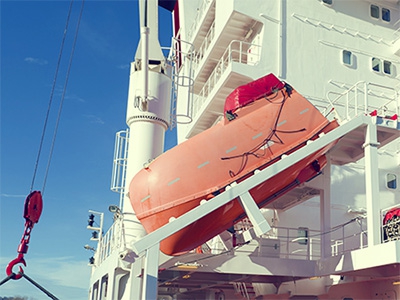Challenges faced and Lessons to be learned
Confidential Hazardous Incident Reporting Programme (CHIRP) has received a report related to lifeboat/rescue boat surveys.
Report text:
“We had a 5yr inspection by Class and we passed all items, including CO2, fire plan, extinguishers, load testing of cranes, etc, etc, but we had a problem with the freefall boat and the rescue boat.
“The first problem was due to the stern lines being in the way of the freefall lifeboat, but the Class surveyor wanted to lower the boat to see if the system was working properly. We eased the tension on the stern ropes to do this, but the vessel moved off the berth. After many attempts to lower the freefall boat the surveyor agreed we should conduct the test on another occasion with the vessel at anchor and send him photographs.
“The second problem I had was when we tried to lower the rescue boat, because we were due to shift along the berth to load one of the after hatches and the inspector was therefore pushed to do the load test on the rescue boats hook ASAP.
“As soon as we finished shifting the vessel the Bosun proceeded to lower the rescue boat to the quayside. The winch had a release handle in the boat for lowering to the sea and also an on-load release hook. After starting to lower the boat, the Bosun noticed that it was lowering faster than was usual with other types of lifeboat and stopped lowering suddenly. This action made the boat jump and the hook released, falling down about 10m, breaking the keel and damaging the hull; fortunately the Bosun escaped without serious injury.
“I hope you can see the problems that may arise from drills and the many kinds of inspections, especiallywhen lowering lifeboats. Many seamen are injured, but not reported.
CHIRP Comment
This report was sent to the UKs Maritime and Coastguard Agency (MCA) and the International Association for Classification Societies for comment. The Maritime Advisory Board is grateful to both organisations for providing detailed responses and wishes to highlight the following extracts; first from the MCA:
IMO MSC/Circ.1093 provides guidance for surveyors on the requirements of SOLAS regulation III/20 – Operational readiness, maintenance and inspections; and SOLAS regulation III/36 – Instructions for on-board maintenance.
From the reported comments regarding the lowering of the boats, it would appear that this was carried out in a rushed manner. Drills of this type should be conducted methodically under full control, following a crew briefing in accordance with established shipboard procedures approved under the company ISM system. The surveyor and company representative, if present, should ideally be in attendance at this briefing so that all persons involved in the drill are aware of the procedures to be adopted.”
And from IACS:
SOLAS regulation III/19, requires that freefall lifeboats are tested in freefall mode to the water once every three months. However, this testing requirement may be extended to six months if every three months the boat is lowered into the water with either a crane or a portal frame. Flag Administrations may allow the freefall mode test to be extended up to 12 months provided the boat is lowered into the water every three months and in addition, a simulated launch takes place every six months. This simulation generally comprises releasing the boat on hangingoff strops so as test the operation of the release mechanism.
There are some Flags who will allow dispensations up to 12 months if certain conditions are met such as crew training in a freefall boat at a recognised centre.
Neither response dealt with the issue of photographs being used to provide the objective evidence required for a Special Survey; is this acceptable? More reports on surveys in general and lifeboats in particular are welcome.
Source:CHIRP































































